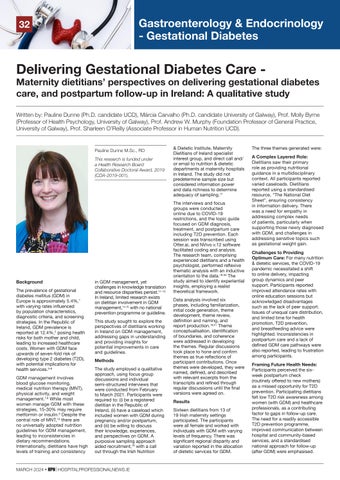Gastroenterology & Endocrinology - Gestational Diabetes
32
Delivering Gestational Diabetes Care -
Maternity dietitians’ perspectives on delivering gestational diabetes care, and postpartum follow-up in Ireland: A qualitative study Written by: Pauline Dunne (Ph.D. candidate UCD), Márcia Carvalho (Ph.D. candidate University of Galway), Prof. Molly Byrne (Professor of Health Psychology, University of Galway), Prof. Andrew W. Murphy (Foundation Professor of General Practice, University of Galway), Prof. Sharleen O’Reilly (Associate Professor in Human Nutrition UCD).
Pauline Dunne M.Sc., RD This research is funded under a Health Research Board Collaborative Doctoral Award, 2019 (CDA-2019-001).
Background The prevalence of gestational diabetes mellitus (GDM) in Europe is approximately 5.4%,1 with varying rates influenced by population characteristics, diagnostic criteria, and screening strategies. In the Republic of Ireland, GDM prevalence is reported at 12.4%,2 posing health risks for both mother and child, leading to increased healthcare costs. Women with GDM face upwards of seven-fold risk of developing type 2 diabetes (T2D), with potential implications for health services.3–6 GDM management involves blood glucose monitoring, medical nutrition therapy (MNT), physical activity, and weight management.7,8 While most women manage GDM with these strategies, 15-30% may require metformin or insulin.9 Despite the central role of MNT,10 there are no universally adopted nutrition guidelines for GDM management, leading to inconsistencies in dietary recommendations. Internationally, dietitians have high levels of training and consistency
in GDM management, yet challenges in knowledge translation and resource disparities persist.11–13 In Ireland, limited research exists on dietitian involvement in GDM management,14,15 with no national prevention programme or guideline. This study sought to explore the perspectives of dietitians working in Ireland on GDM management, addressing gaps in understanding and providing insights for potential improvements in care and guidelines. Methods The study employed a qualitative approach, using focus group discussions and individual semi-structured interviews that were conducted from February to March 2021. Participants were required to: (i) be a registered dietitian in the Republic of Ireland, (ii) have a caseload which included women with GDM during pregnancy and/or postpartum, and (iii) be willing to discuss their knowledge, experiences, and perspectives on GDM. A purposive sampling approach aided recruitment,16 with a call out through the Irish Nutrition
MARCH 2024 • HPN | HOSPITALPROFESSIONALNEWS.IE
& Dietetic Institute, Maternity Dietitians of Ireland specialist interest group, and direct call and/ or email to nutrition & dietetic departments at maternity hospitals in Ireland. The study did not predetermine sample size but considered information power and data richness to determine adequacy of sampling.17 The interviews and focus groups were conducted online due to COVID-19 restrictions, and the topic guide focused on GDM diagnosis, treatment, and postpartum care including T2D prevention. Each session was transcribed using Otter.ai, and NVivo v.12 software facilitated coding and analysis. The research team, comprising experienced dietitians and a health psychologist, performed reflexive thematic analysis with an inductive orientation to the data.18-20 The study aimed to identify experiential insights, employing a realist theoretical framework. Data analysis involved six phases, including familiarization, initial code generation, theme development, theme review, definition and naming, and report production.18,21 Theme conceptualisation, identification of boundaries, and coherence were addressed in developing the themes. Regular discussions took place to hone and confirm themes as true reflections of participant contributions. Once themes were developed, they were named, defined, and described with relevant excerpts from the transcripts and refined through regular discussions until the final versions were agreed on. Results Sixteen dietitians from 13 of 19 Irish maternity settings participated. The participants were all female and worked with individuals with GDM with varying levels of frequency. There was significant regional disparity and variation reported in the allocation of dietetic services for GDM.
The three themes generated were: A Complex Layered Role: Dietitians saw their primary role as providing nutritional guidance in a multidisciplinary context. All participants reported varied caseloads. Dietitians reported using a standardised resource, "The National Diet Sheet", ensuring consistency in information delivery. There was a need for empathy in addressing complex needs of patients, particularly when supporting those newly diagnosed with GDM, and challenges in addressing sensitive topics such as gestational weight gain. Challenges to Providing Optimum Care: For many nutrition & dietetic services, the COVID-19 pandemic necessitated a shift to online delivery, impacting group dynamics and peer support. Participants reported improved attendance rates with online education sessions but acknowledged disadvantages such as the lack of peer support. Issues of unequal care distribution, and limited time for health promotion, T2D prevention, and breastfeeding advice were highlighted. Inconsistencies in postpartum care and a lack of defined GDM care pathways were also reported, leading to frustration among participants. Framing Future Health Needs: Participants perceived the sixweek postpartum check (routinely offered to new mothers) as a missed opportunity for T2D prevention. Participating dietitians felt low T2D risk awareness among women (with GDM) and healthcare professionals, as a contributing factor to gaps in follow-up care. The need for a readily accessible T2D prevention programme, improved communication between hospital and community-based services, and a standardised national approach for follow-up (after GDM) were emphasised.
